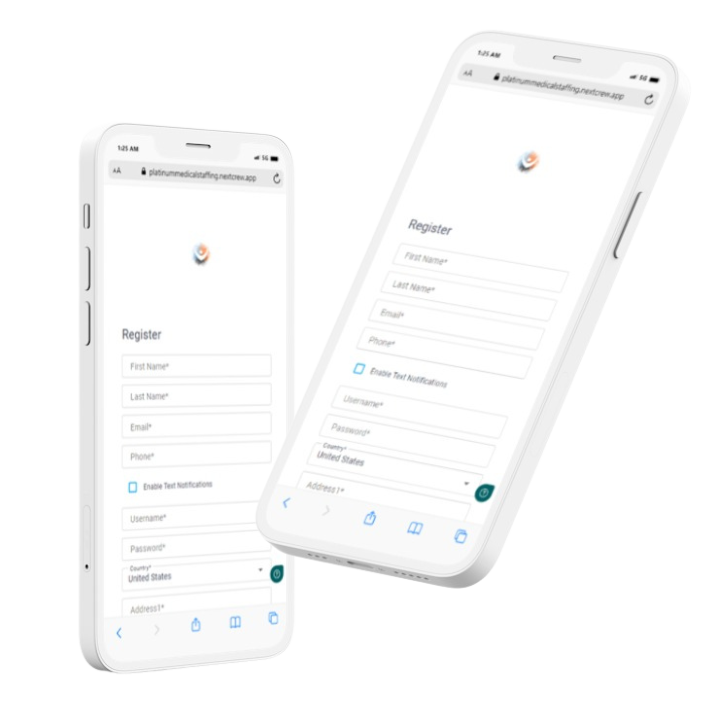Platinum Medical Staffing (formerly Platinum Surgical Assistants)
Register Now for Our Brand New Medical Staffing Mobile App!
Welcome to Platinum Medical Staffing - Your Premier Destination for Medical Staffing in Maryland, Virginia, and Washington D.C.
Download App Now

Welcome To Platinum Medical Staffing
Welcome to Platinum Medical Staffing, We provide medical staffing in Maryland, Virginia, and Washington D.C. With a commitment to excellence, we strive to provide healthcare facilities with the highest quality staffing solutions tailored to their unique needs. Our team of experienced medical professionals has a deep understanding of the healthcare industry and we use this knowledge to find the best talent for your facility. We specialize in providing a range of staffing solutions including temporary, per diem, travel, and permanent placement services. We are dedicated to ensuring that our staffing services meet your needs and exceed your expectations. At Platinum Medical Staffing, we believe that outstanding healthcare requires outstanding people, and we are passionate about connecting healthcare facilities with top-quality talent. Our rigorous screening and hiring process ensures that our staff members are highly trained, qualified, and experienced. Partner with Platinum Medical Staffing and experience the highest quality staffing services for your healthcare facility. Contact us today and discover why we are the preferred staffing provider for healthcare facilities in Maryland.
Exclusive Opportunities Await: Join Our Platinum Medical Staffing Community!
Jobs and Assignments for Every Type of Medical Professional Including
Registered
Nurse (RN)
Our extensive network includes experienced and compassionate registered nurses ready to provide exceptional care to your patients.
Surgical
Assistants
Trust our skilled surgical assistants to support your surgical team and ensure smooth operations in the operating room.
Licensed Practical Nurse (LPN)
Depend on our licensed practical nurses to deliver personalized care and assist in daily patient routines with professionalism and empathy.
Certified Nursing Assistant (CNA)
Count on our certified nursing assistants to provide essential support to patients and contribute to their overall comfort and well-being.

Why Choose Platinum Medical Staffing?
The value of Platinum Medical Staffing can be considered priceless. We provide low-cost solutions that fit today’s ever-changing healthcare needs by easing the workload and minimizing the stress of a hospital’s staff. Our dependable and certified team of medical professionals offers a consistent source help and support to medical facilities. We offer a low-cost solution for all medical staffing in Maryland, Virginia, and Washington D.C. Our medical professionals are certified and professional. Our medical professionals are formally educated in surgical procedures. Our team will execute intraoperative functions to provide better patient care. We are a dependable source of aid to hospitals for all their staffing needs.
Comprehensive Staffing Solutions for
Every Medical Facility
Hospitals
Our extensive network of highly qualified healthcare professionals enables us to provide top-notch staffing solutions for hospitals of all sizes.
Surgery
Centers
Trust Platinum Medical Staffing to provide you with experienced surgical technicians, nurses, and administrative staff to ensure optimal patient care and operational efficiency.
Assisted
Living
Our team of compassionate caregivers and support staff is dedicated to enhancing the quality of life for residents while ensuring their safety and well-being.
Hospice
Our carefully vetted staff members are equipped to provide the highest level of care and support to patients and their families during their time of need.
Stay Connected
Frequently Asked Questions
As defined by the American College of Surgeons, the surgical assistant provides aid in exposure, hemostasis, closure, and other intraoperative technical functions that help the surgeon carry out a safe operation with optimal results for the patient. In addition to intraoperative duties, the surgical assistant also performs preoperative and postoperative duties to better facilitate proper patient care. The surgical assistant to the surgeon during the operation does so under the direction and supervision of that surgeon and in accordance with hospital policy and appropriate laws and regulations.
The majority of surgical assistants are not participants in insurance networks.
You were either designated as Self Pay or Private Insurance. If we sent the medical claim to your private insurance, this company has determined that you are responsible for a portion of the charges.
While many surgeons advise their patients prior to surgery, some do not wish to burden their patients with additional information that they feel would not be important to their patient’s surgery and recovery. Surgeons make several decisions like this throughout the entire process, such as which anesthesia to use, which instruments are required, etc.
PSA normally receives insurance information from the hospital where you had your surgery. Once this information is complete and ready to go we will send a claim directly to your insurance carrier. If you wish to verify that the information we have is accurate & complete, please fill out the back of the stub that came with your bill giving us full insurance information, including your identification number, your group number, and the name of the insured person and his or her date of birth. Please also send us a photocopy of the front and back of your insurance card.
Platinum Surgical Assistants is the cost-effective way to reduce some of the stress that comes along with a hospital setting by taking some of the workload off your hospital staff. Outsourcing the workload to our assistants is also typically 10-20% less expensive than managing a complete team of surgical assistants in-house.


